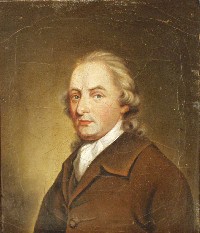Roger Kemble facts for kids
Roger Kemble (born March 1, 1721 – died December 6, 1802) was an English theatre manager and actor. He was known as a "strolling player," which meant he traveled around performing in different towns.
In 1753, Roger Kemble married Sarah "Sally" Ward, an Irish actress. They had thirteen children together. Many of their children grew up to become famous actors and actresses. They were part of the well-known Kemble family of performers in the 1800s.
Contents
Roger Kemble's Life in Theatre
Roger Kemble was born in Hereford, England. He started his career in theatre in 1752, joining a group of actors in Canterbury. He later moved to Birmingham to work for a theatre manager named John Ward. Roger Kemble eventually married Ward's daughter, Sarah.
Becoming a Theatre Manager
When John Ward retired, Roger Kemble took over his first theatre management job in Leominster in 1766. After marrying Sarah Ward, he started his own traveling theatre company. For the next fifteen years, Roger, Sarah, and their children toured together, performing plays.
His Famous Children
Five of Roger Kemble's children became very famous actors. Many of his grandchildren also followed in their footsteps. His oldest child, Sarah Siddons, became one of the most celebrated actresses of her time.
Sarah Siddons first acted on stage in 1766. She played the character Ariel in the play The Tempest with her father's company. In 1767, another actor named William Siddons joined the company. Sarah married him in 1773 and continued her acting career as Mrs. Siddons.
While Roger Kemble was a successful theatre manager, he was not as famous as his children. However, he did have a notable performance in London. In 1788, he played the character Falstaff in Shakespeare’s play Henry IV, Part 1 at the Haymarket Theatre.
Roger Kemble's Legacy
Roger Kemble is remembered in his hometown of Hereford. There is a special plaque at 28-29 Church Street, marking the place where he was born. Also, a street in London, Kemble Road in Forest Hill, is named after him.


